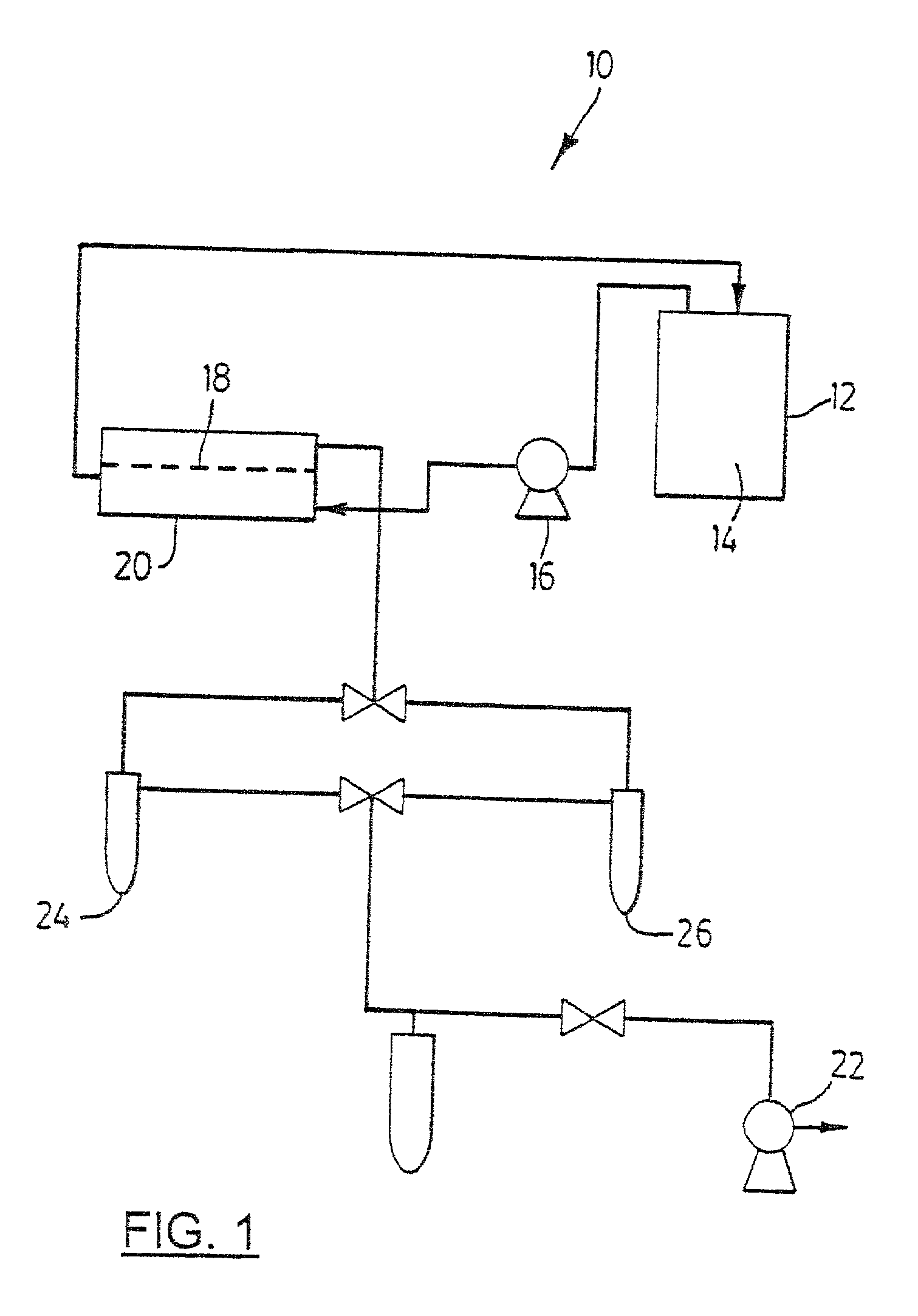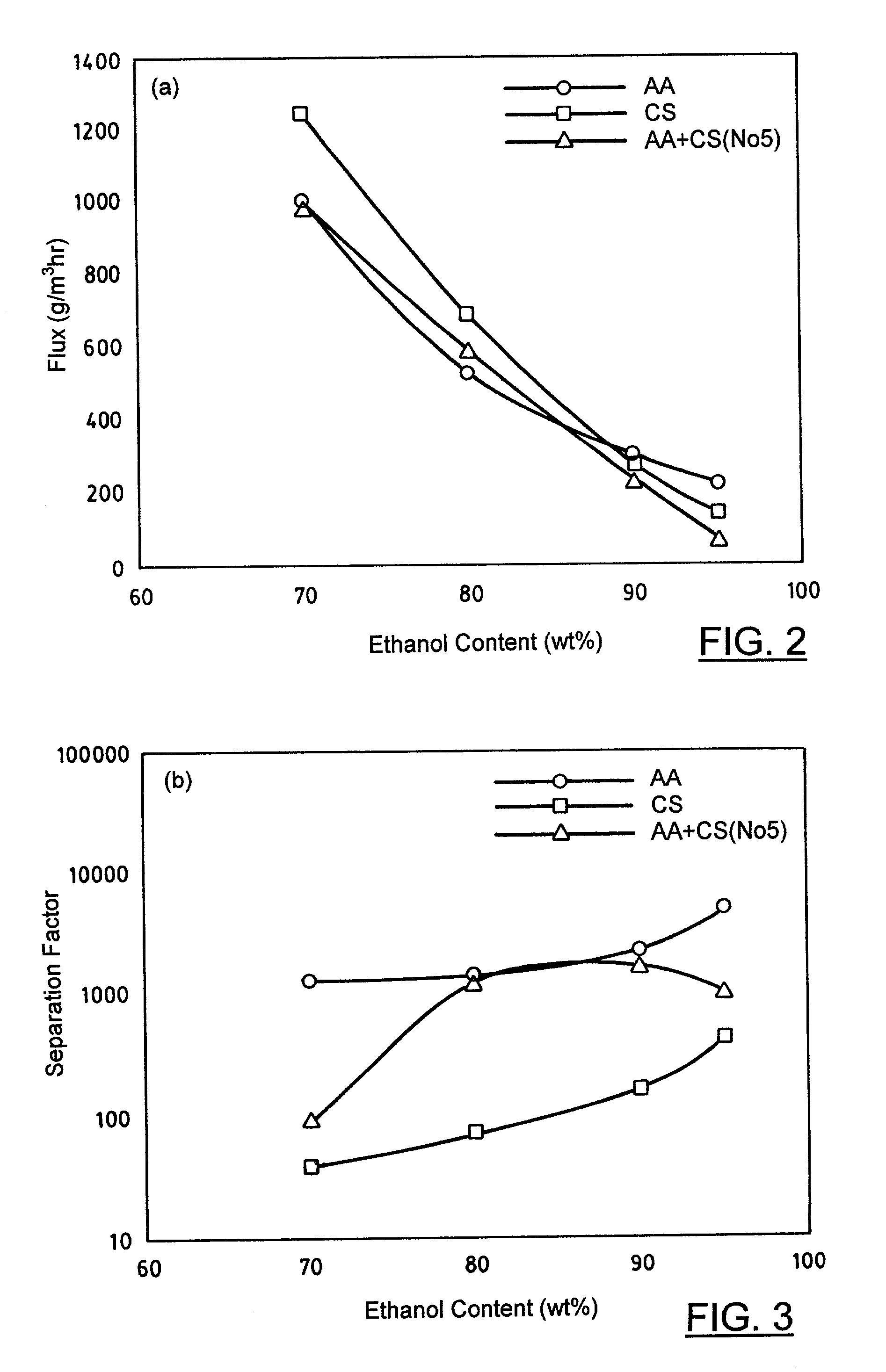Novel composite membrane
a composite membrane and composite membrane technology, applied in the field of composite membranes, can solve the problems of low selectivity, inability to achieve acceptable separation, weak wet strength, etc., and achieve good water selectivity, mechanical stability, and good pernselectivity
- Summary
- Abstract
- Description
- Claims
- Application Information
AI Technical Summary
Benefits of technology
Problems solved by technology
Method used
Image
Examples
example 2
[0055] A second double layer membrane was prepared in similar manner as the double layer membrane in Example 1, with the exception that the treatment solution was a solution of a crosslinking agent which consisted of a formaldehyde solution prepared with 6% formaldehyde, 0.5% HCI catalyst in 50% aqueous acetone solution. The double layer membrane was immersed in the formaldehyde crosslinking solution for 24 hours.
[0056] Pervaporation experiments, similar to those described in Example 1, were carried out for isopropanol-water mixtures using the second double layer membrane, a pure alginate membrane, and a pure chitosan membrane. The concentration of the isopropanol-water feed mixture was varied from 70 to 95 wt %.
[0057] FIGS. 4 and 5 show the pervaporation results conducted at various isopropanol concentrations at 60.degree. C. for the second double layer membrane, pure alginate membrane and pure chitosan membrane. The second double layer membrane was treated in the formaldehyde solu...
example 3
[0058] The double layer membrane of Example 1 was used in pervaporation experiments carried out for ethanol-water and isopropanol-water mixtures having feed concentrations ranging from 50 wt % water to 90 wt % water. The operating temperature was 60.degree. C., and the results are presented in Table 1. The membranes maintained their integrity even for 90% water mixtures and showed good water selectivities.
1TABLE 1 Alcohol Ethanol Isopropanol content in EtOH PrOH the feed Flux content in Separation Flux content in Separation (wt %) (g / m.sup.2 hr) the permeate factor (g / m.sup.2 hr) the permeate factor 50% 4742 22.87% 3.4 3947 3.4% 28 30% 7345 8.3% 4.7 5833 1.5% 27.8 10% 9893 1.1% 10 8991 0.55% 20
example 4
[0059] The double layer membrane of Example 2 was used in pervaporation experiments carried out for ethanol-water and isopropanol-water mixtures having feed concentrations ranging from 50 wt % water to 90 wt % water. The operating temperature was 60.degree. C. The experimental results are presented in Table 2. The membranes maintained their integrity across the range of feed water concentrations studied.
[0060] The permeation fluxes through formaldehyde crosslinked membrane are higher than those of sulphuric acid treated membrane of Example 3. Not surprisingly, separation factors were markedly reduced for feed mixtures with high water content.
2TABLE 2 Alcohol Ethanol Isopropanol content in EtOH PrOH the feed Flux content in Separation Flux content in Separation (wt %) (g / m.sup.2 hr) the permeate factor (g / m.sup.2 hr) the permeate factor 50% 7,408 14.652% 5.8 6,108 2.899% 33.5 30% 12,124 9.484% 4.1 8,756 5.685% 7.1 10% 23,205 5.265% 2 18,679 3.092% 3.5
[0061] In view of the above-descr...
PUM
| Property | Measurement | Unit |
|---|---|---|
| thickness | aaaaa | aaaaa |
| thickness | aaaaa | aaaaa |
| thickness | aaaaa | aaaaa |
Abstract
Description
Claims
Application Information
 Login to View More
Login to View More - R&D
- Intellectual Property
- Life Sciences
- Materials
- Tech Scout
- Unparalleled Data Quality
- Higher Quality Content
- 60% Fewer Hallucinations
Browse by: Latest US Patents, China's latest patents, Technical Efficacy Thesaurus, Application Domain, Technology Topic, Popular Technical Reports.
© 2025 PatSnap. All rights reserved.Legal|Privacy policy|Modern Slavery Act Transparency Statement|Sitemap|About US| Contact US: help@patsnap.com



